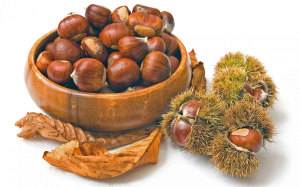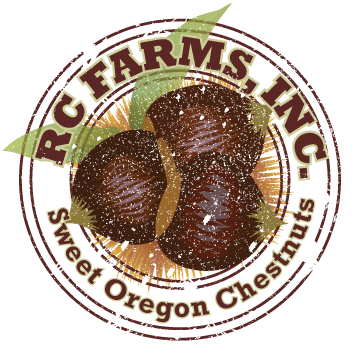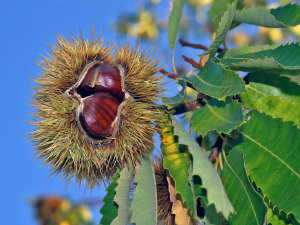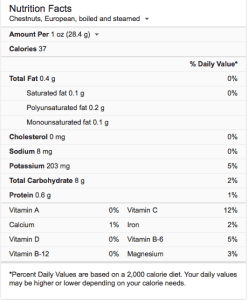Chestnut 411

Fresh Autumn Chestnuts
When Columbus discovered America, the principal native timber was chestnut. When the earliest settlers came to the East Coast, they made log cabins and fences principally from chestnut – a long-enduring, termite-proof wood.
Nuts from the towering 100-foot tall trees were nourishing food for pioneers – vital for surviving the winter. Chestnuts were used for the livestock, for hog feed. Deer and other wild animals depended on them. Chestnuts were as common – almost as routine in the diet – as milk.
Over the decades, the all-American scene moved on: “chestnuts roasting on the open fire”; chestnut stuffing for Thanksgiving as traditional as cranberries. Vendors sold roasted chestnuts on eastern city streets. And as America’s pot began to meld and Asians and Europeans came to America, they brought with them their culture’s appreciation for the nuts. All this mostly enbeknownst to westerners.
Then came a true biological disaster – the loss of that area’s major forest tree – a disaster with considerable economic consequence.
It came about, some say, in the early 1900s before the days of quarantine, when a Chinese chestnut was brought to New York to be planted in a park. That tree introduced chestnut blight to those East Coast chestnuts. During the next several decades, that blight decimated America’s entire chestnut industry.
From wikipedia:
The chestnut belongs to the same family as the oak and beech. The four main species are commonly known as European, Chinese, Japanese and American chestnuts, some species called chinkapin or chinquapin:[4]
- European species sweet chestnut (Castanea sativa) (also called “Spanish chestnut” in the US) is the only European species of chestnut, though was successfully introduced to the Himalayas and other temperate parts of Asia. Unrelated, but externally similar species of horse chestnut are abundant around Europe.
- Asiatic species Castanea crenata (Japanese chestnut), Castanea mollissima (Chinese chestnut), Castanea davidii (China), Castanea henryi (Chinese chinkapin, also called Henry’s chestnut – China) and Castanea seguinii (also called Seguin’s chestnut – China)
- American species These include Castanea dentata (American chestnut – Eastern states), Castanea pumila (American- or Allegheny chinkapin, also known as “dwarf chestnut” – Eastern states), Castanea alnifolia (Southern states), Castanea ashei (Southern states), Castanea floridana (Southern states) and Castanea paupispina (Southern states).
Chestnuts should not be confused with horse chestnuts (genus Aesculus), which are not related to Castanea and are named for producing nuts of similar appearance, but which are mildly poisonous to humans, nor should they be confused with water chestnut (family Cyperaceae), which are also unrelated to Castanea and are tubers of similar taste from an aquatic herbaceous plant. Other trees commonly mistaken for the chestnut tree are the chestnut oak (Quercus prinus) and the American beech (Fagus grandifolia).


